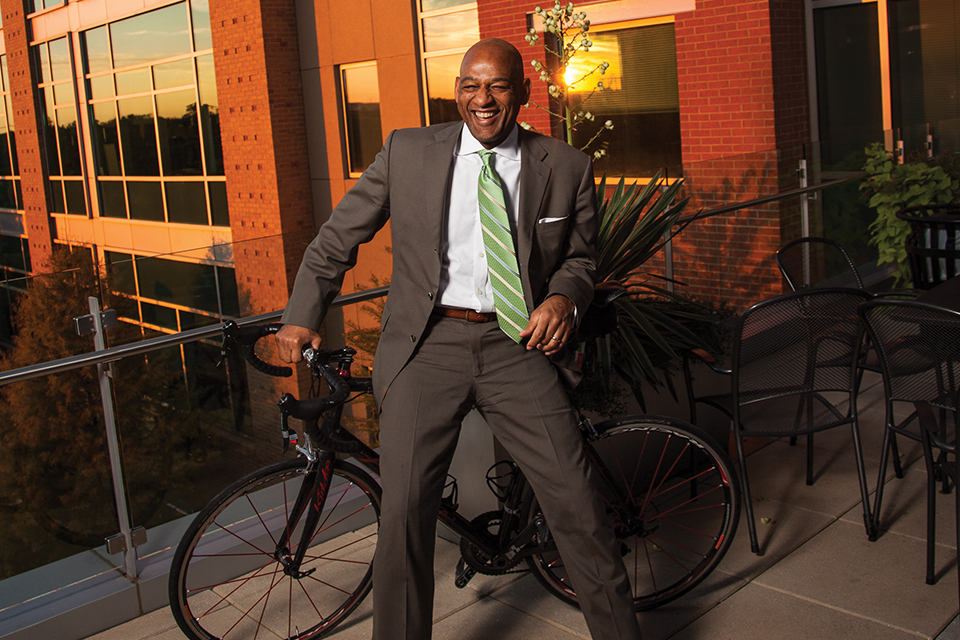For Health, Fitness, and Fun

When it comes to working out, Herb Dyer doesn’t know the meaning of the word “excuse.” The 55-year-old vice president and chief operating officer at University Medical Center Brackenridge has been demonstrating to the community for years that discipline, documentation, and scheduling are his factors for success when it comes to living a healthy, active lifestyle.
Fitness has always come naturally to Dyer, who participated in a variety of sports growing up. “I ran track in high school, focused on martial arts, and, in between, I did fitness things such as weight training,” he said, “I’ve continued some level of aerobic activity throughout (my entire life).”
It was a century ride—100 miles on a bike—benefiting AIDS research that launched Dyer into the cycling world in his late twenties. “The first event I did was in the early 1990s, where I rode from Boston, Massachusetts to New York,” he reminisced. “That was my first long-distance ride supporting that particular fund-raiser…a few years later, I did a 625-mile ride in Montana over a six-day period.” Eventually, Dyer found his interest in cycling growing stronger, and he eased his focus on running and weight training in favor of his newfound sport.
Over the years, Dyer has participated in many century and fundraising rides; how-ever, his primary motivation for getting on his bike has always been fitness—and, of course, having fun. “I ride for fun and for my sanity,” he laughed. “Obviously, in terms of my job, it’s very stressful, but I’m 55 years old and I’ve always been in fairly decent shape, so it’s part of my lifestyle; it’s my spirituality.”
Dyer has also always appreciated the competitive aspect of the sport and, although he doesn’t compete, he occasionally challenges himself by participating in group rides with Category 1, 2, and 3 racers. “I’ll ride with them and, whenever they do intervals, I do my best to stay with them,” he explained.
Dyer has always been an advocate for healthy living, but he had no idea his per-sonal passion would inspire so many others to follow in his footsteps. While acting as president and chief operating officer at Seton Medical Center Hays from 2009 to mid-2013, Dyer began riding after work once a week, from Kyle to San Marcos, on his fixed-gear bicycle. “I’d ask my secretary to not schedule anything after 5 p.m., and I’d go out solo,” he said. “I’d ride…to Texas State—about 30 miles.”
Word soon began to spread about Dyer’s weekly cycling excursion, and it wasn’t long before a handful of Seton employees asked if they could accompany him. The impromptu cycling group had approximately five members during the first year of its inception, and eventually grew to around 12. Dyer made sure that the group was inclusive, welcoming cyclists of all levels—from the seasoned rider to the newbie athlete. “Of course, you had different levels of fitness,” he admitted. “The stronger riders would take off, and I would share my time between the stronger riders and the ones who were training. We had a couple beginners, and I would work with them the first ten or so miles, teaching them cadence, bike-handling skills, (and) safety-riding skills as well.” Dyer is proud of the fact that many in the Seton cycling group have gone on to compete in triathlons, the MS 150 (a two-day charity ride sponsored by the National Multiple Sclerosis Society), and other local cycling events.
On average, Dyer rides approximately eight to ten hours per week—or 130 to 170 miles—dividing that time between the stationary trainer and the road. “I’ll spin two to three days on a weekday for an hour or an hour and 15 minutes,” he said. “In terms of a routine ride, I do the dam loop. It combines [Highways] 360, 620, Bee Caves Road, and some back roads to connect 360 to 620. That’s roughly a 41-mile ride for me, say, on Saturday or Sunday.”
When Dyer’s friends and co-workers offer up the excuse that they just don’t have the time to work out, he assures them, “If I can find time to work out for eight to ten hours a week, I know you can do that (too).” He encourages them to go beyond a verbal commitment to exercise, instead putting their goals down in writing. “Document it; put it on your schedule,” he asserted. “If you don’t know what you want to do, meet with someone who has that experience—jogging, cycling, swimming—get with that expert and have a discussion…and make sure you do it.”
The side benefit of staying active, Dyer joked, is that it makes the occasional dietary indulgence more easily justifiable. “I like good food; that’s another excuse for me to stay in shape and exercise,” he said. Although he sticks to a relatively healthy diet, he does allow himself to splurge once or twice a week on some of his favorite vices: single-malt scotch, red wine, and dessert. The key, he said, is balance.
A recent injury—a torn meniscus that required surgery—became an unexpected setback for Dyer at the end of the summer. He admitted that the recovery process is both arduous and frustrating at times; however, he is already back on his stationary bike, riding without resistance for now, determined to stay active in whatever way he can. If Dyer’s self-discipline and personal drive are any indication of his chances for a successful recovery, it is likely he’ll be back out on the road again soon—continuing to inspire others along the way.






